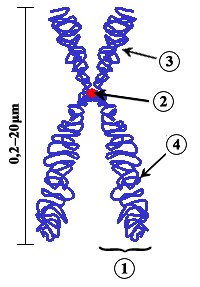
Chromosomes are organized structures of DNA and proteins that are found in cells. Chromosomes contain a single continuous piece of DNA, which contains many genes, regulatory elements and other nucleotide sequences. Chromosomes also contain DNA-bound proteins, which serve to package the DNA and control its functions. The word chromosome comes from the Greek χρῶμα (chroma, color) and σῶμα (soma, body) due to their property of being stained very strongly by some dyes.
Chromosomes vary extensively between different organisms. The DNA molecule may be circular or linear, and can contain anything from tens of kilobase pairs to hundreds of megabase pairs. Typically eukaryotic cells (cells with nuclei) have large linear chromosomes and prokaryotic cells (cells without nuclei) smaller circular chromosomes, although there are many exceptions to this rule. Furthermore, cells may contain more than one type of chromosome; for example mitochondria in most eukaryotes and chloroplasts in plants have their own small chromosomes.
In eukaryotes, nuclear chromosomes are packaged by proteins into a condensed structure called chromatin. This allows the massively-long DNA molecules to fit into the cell nucleus. The structure of chromatin varies through the cell cycle, and is responsible for the organisation of chromosomes into the classic four-arm structure during mitosis and meiosis.
"Chromosome" is a rather loosely defined term. In prokaryotes, a small circular DNA molecule may be called either a plasmid or a small chromosome. These small circular genomes are also found in mitochondria, and chloroplasts, reflecting their bacterial origins. The simplest chromosomes are found in viruses: these DNA or RNA molecules are short linear or circular chromosomes that often lack any structural proteins.
History
Chromosomes were first observed in plant cells by a Swiss botanist named Karl Wilhelm von Nägeli in 1842, and independently in Ascaris worms by Belgian scientist Edouard Van Beneden (1846-1910). The use of basophilic aniline dyes was a fundamentally new technique for effectively staining the chromatin material in the nucleus. Their behavior in animal (salamander) cells was later described in detail by German cytologist and professor of anatomy Walther Flemming, the discoverer of mitosis, in 1882. The name was invented later by another German anatomist, Heinrich von Waldeyer in 1888.
No comments:
Post a Comment